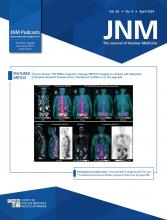Abstract
18F-rhPSMA-7, and its single diastereoisomer form, 18F-rhPSMA-7.3, are novel prostate specific membrane antigen (PSMA)-targeting radiopharmaceuticals. Here, we investigated their accuracy for the assessment of lymph node metastases validated by histopathology. Methods: Data from 58 patients with biochemical recurrence of prostate cancer after radical prostatectomy receiving salvage surgery after positron emission tomography (PET) imaging with 18F-rhPSMA-7 or 18F-rhPSMA-7.3 were retrospectively reviewed. Two nuclear medicine physicians reviewed all PET scans and morphological imaging in consensus. Readers were blinded from the results of histopathology. PET and morphological imaging were correlated with histopathology from resected lymph nodes. Results: In 75 of 150 resected regions in 54 of 58 patients, tumor lesions were present in histopathology. The template-based specificity of PET (18F-rhPSMA-7 and 18F-rhPSMA-7.3 combined) and morphologic imaging were 93.3% and 100%, respectively. However, 18F-rhPSMA-7 and 18F-rhPSMA-7.3 PET detected metastases in 61 of 75 histopathologically proven metastatic LN fields (81.3%) whereas morphologic imaging was positive in only 9 of 75 (12.0%). The positive predictive value for 18F-rhPSMA-7 and 18F-rhPSMA-7.3 PET was 92.4% vs 100% for morphological imaging. 18F-rhPSMA-7 and 18F-rhPSMA-7.3 PET performance was significantly superior to morphological imaging (difference in the areas under the receiver-operating-characteristic curves, 0.222; 95% confidence interval, 0.147-0.298; p<0.001). Mean size of PET-positive and histologically confirmed LN metastases was 6.3±3.1 mm (range, 2-15 mm) compared to a mean size of 9.8 ± 2.5 mm (range, 7-15 mm) in morphological imaging. Conclusion: 18F-rhPSMA-7 and 18F-rhPSMA-7.3 PET offer a high positive predictive value comparable to that reported for 68Ga-PSMA-11 and represent a valuable tool for guiding salvage lymphadenectomy.
- Genitourinary
- Oncology: GU
- PET/CT
- 18F-rhPSMA-7
- 18F-rhPSMA-7.3
- biochemical recurrence
- prostate cancer
- salvage surgery
- Copyright © 2022 by the Society of Nuclear Medicine and Molecular Imaging, Inc.







